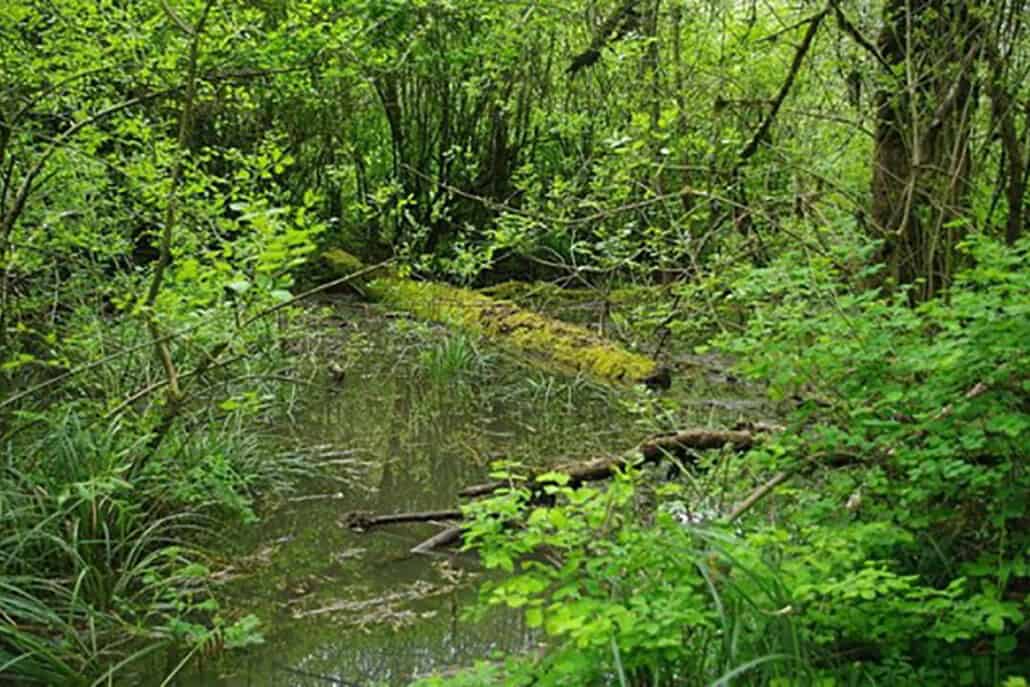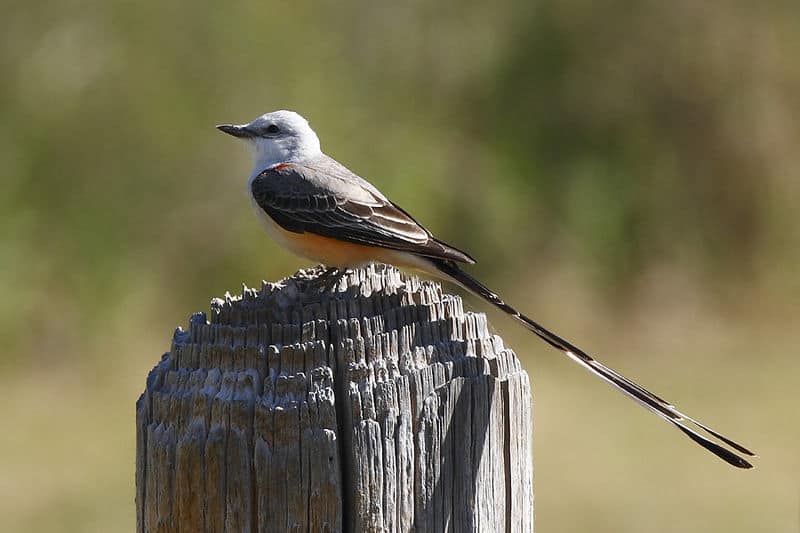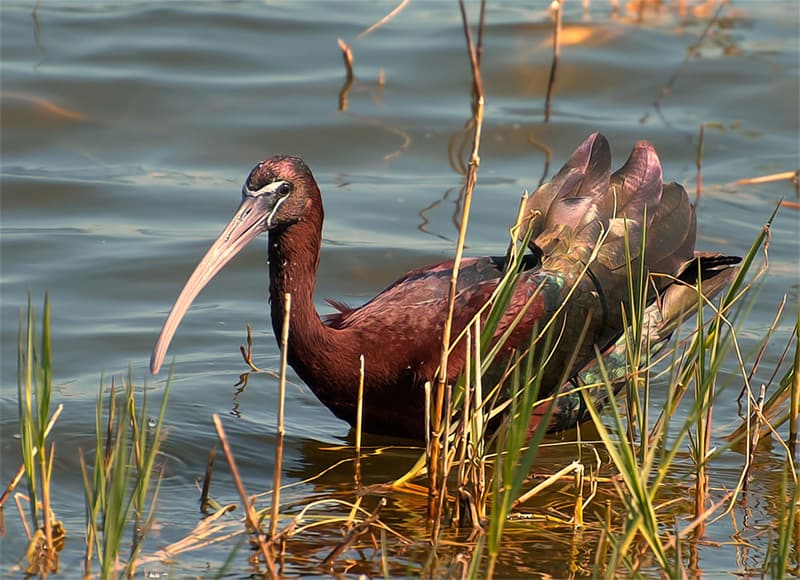Big Oak Tree State Park
13640 South Highway 102
East Prairie, Mo. 63845
Phone: 573-649-3149
Established in 1938, the park is primarily a bottomland hardwood forest. It is named Big Oak Tree for a reason—the tree canopy averages 120 feet in height. To reach the park, take Interstate 55 into the Mississippi Lowlands of Southeast Missouri, exiting at the 58-mile marker on Missouri Highway 80 east to East Prairie. A mile east of East Prairie, turn right on Mo. Highway 102 to the park.
A 1.25-mile boardwalk (round trip, and handicapped-accessible) takes visitors through the park’s giant trees and cypress swamp. Two permanent residents in the park and on nearby Seven Island Conservation Area are black vulture and fish crow. Summer residents include prothonotary, northern parula, hooded, and yellow-throated warblers and Mississippi kite. Black-necked stilts are a new addition to the park list.
The park, situated like an island in a sea of agricultural lands, makes it a welcomed stop for spring migrants.
Bush Conservation Area and Weldon Spring Conservation Area
Missouri Department of Conservation
St. Louis Regional Office
2360 Highway D
St. Charles, Mo. 63304
Phone: 636-441-4554
Busch CA is 7,000 acres of a World War II TNT brewing depot, including 30 human-made lakes. Pine groves, mature upland and bottomland forests, marshes, and both weedy and cultivated fields are just a few of the bird-rich habitats here.
Weldon Spring CA has 7.360 acres and is much the same habitat as the Busch area, but adds the Missouri River floodplain to the mix.
To reach the areas, take Interstate 64 into West St. Louis County. Just west of the Missouri River Bridge (St. Charles County), go south on Missouri Highway 94 to Route D. Busch headquarters is two miles to the T on Route D.
An array rarities have been recorded here, including ruff, glossy ibis, surf scoter, garganey, vermilion flycatcher, Say’s phoebe, Bachman’s sparrow, Swainson’s warbler, and green-tailed towhee.
The Busch Area allows birding by auto, but Weldon Spring must be covered bike or on foot from parking lots at four trailheads on Highway 94.
Eagle Bluffs Conservation Area
Missouri Dept. of Conservation
Central Regional Office
Hillcrest Dr.
Columbia, Mo. 65201
Phone: 573-445-3882
Located in Boone County in the Missouri River floodplain eight miles south of Columbia, this area has been re-established as a traditional stop for migratory birds and an improved home for permanent residents.
Roads carry observers through much of the area and up to the north bank of the Missouri River. Hiking is permitted on the levees and canoes are allowed when and where water levels permit. The pools are managed primarily for waterfowl, but shorebirds and waders are common here. Night herons and both bitterns visit and bald eagles visit in the winter. Because of grain fields nearby, the area has many varieties of sparrows, changing with the seasons.
To reach Eagle Bluffs, go south from the University of Missouri football stadium on Providence Road, which eventually becomes Route K. Follow Route K to McBaine, then left on Star School Road to the wetlands. Part of the area is closed during the waterfowl-hunting season (October 15–February 15).
Mingo Wildlife Refuge
24279 State Highway 51
Puxico, Mo. 63960
Phone: 573-222-3589
Located a short drive north of Puxico on Missouri Highway 51, the 21,676 acres of swamps, marshes, and bottomland hardwoods are all that remain of 2+ million acres of hardwoods that once covered the Mississippi Lowlands. Twenty-five thousand years ago the Mississippi River flowed 60 miles west of its current location. Some 18,000 years ago it shifted directions, leaving behind what is now Mingo NWR.
The refuge includes 4,700 acres of swamp and marshland, bottomland, and upland forests, grasslands, and croplands that make the refuge a treasure trove for birders, botanists, and herpetologists. The refuge lists more than 280 species of birds, 23 amphibians, 37 reptiles, 38 mammals, and botanical mix of northern, eastern and southern wildflowers. A one-mile boardwalk is a spring trek not soon forgotten. There are two driving routes with many stops. Nearby are two additions—Duck Creek Conservation Area and Lake Wappapello.
Riverlands Environmental Demonstration Area
U.S. Army Corps of Engineers
Rivers Project Office
301 Riverlands Way
West Alton, Mo. 63386
Phone: 636-899-2600
This area in St. Charles County is 1,200 acres of former cropland that has been restored to flooded lowlands, prairie, and bottomland forest and marsh. It is easily reached from Interstate 270 in North St. Louis County. Exit at Missouri Highway 367, which will merge with U.S. 67. Two miles after crossing the Missouri River, turn right onto Riverland Way.
Possibly no place in the Midwest can match Riverlands and adjacent Alton Dam and Locks area for water birds. As many as 18 gull species have been seen here, including slaty-backed, glaucous-winged, and Ross’ Gulls. The rarity list includes jaegers, loons, neotropical cormorant, wood stork, surf scoter, purple gallinule, smew, harlequin duck, and Barrow’s goldeneye, among others. Every day is an adventure here. In addition, you are almost sure to see Eurasian tree sparrows in the underbrush. A scope makes water bird viewing easier here as one scans the flotillas of birds on the rivers and pools.
Schell-Osage Conservation Area
Schell-Osage Conservation Area
PO Box 123
Schell City, Mo. 64783
Phone: 417-876-5226
Located in St. Clair and Vernon counties, Schell-Osage is one of the state’s premier birding spots. Its 8,600 acres include a small prairie, 1,200 acres of open marsh, 430 acres of flooded timber, two lakes, and plenty of oak and hickory bottomland forest, cedar tickets, a pine grove, and numerous sloughs and oxbows along the Osage River.
To reach the area, turn north off U.S. Highway 54 west of El Dorado at Route AA for 10 miles to Route RA, then east to the headquarters. Schell-Osage offers the best in spring and fall migration and most of the birds that birders expect in such a mixture of habitats. However, much of the area is closed during waterfowl hunting season (October 15February 15).
A visit to Taberville Prairie Conservation Area offers a booming greater prairie-chicken lek in the spring and 1,600 acres of prairie habitat only a few minutes east of Schell-Osage.
Squaw Creek National Wildlife Refuge
Squaw Creek NWR
Highway 159 South
Mound City, Mo. 64470
Phone: 660-442-3187
Squaw Creek is located 90 minutes north of Kansas City just off Interstate 29. Directions: Take Missouri Highway 159 west at exit 79 for two miles to the headquarters and entrance.
For sheer numbers of birds, few places in the United States can match Squaw Creek in the fall and spring, when up to 400,000 snow geese will stop. A 10-mile loop drive runs through pools of cattails, lotus, arrowhead, and past mud flats, open fields, old woodlands, meadows and scrub habitat.
In winter the refuge hosts several hundred bald eagles. Ross’ geese can be found in the snow goose flocks and as many as 8,000,000 blackbirds have been logged on Christmas Bird Counts. Harlan’s hawks are common here in winter as are short-eared owls.
In spring migration, all three phalarope species can be seen. In the summer, least bitterns, yellow-headed blackbirds, and great-tailed grackles breed here.
Table Rock Dam and Lake
U.S. Army Corps of Engineers
4600 State Highway 165 So.
Branson, Mo. 65616
Phone: 417-334-4101
Country music fans know Branson, Missouri. Table Rock Lake is only a few minutes southwest of Branson on Highways 76 and 165. Winter is an exciting time here, with Black and Turkey Vulture roosts just across the dam at Shepherd of the Hills Fish Hatchery. Field sparrows abound throughout and Table Rock Lake has been a winter base in recent years for a variety of grebes and both Pacific and yellow-billed loons.
Only a few minutes from Table Rock is the Henning Conservation Area where both painted buntings and roadrunners are a good bet in spring and summer. Summer birders will find prothonotary, northern parula, Kentucky, prairie and cerulean warblers. Though the area has become almost metropolitan, it still has nooks and crannies that hold a colorful world of avian and botanical life. For help in finding them, contact the Greater Ozarks Audubon Society, PO Box 3231, Springfield, Mo. 65808.
Prairie State Park
Department of Natural Resources
Prairie State Park
128 NW 150th Lane
Liberal, MO 64762
Phone: 417-843-6711
Prairie State Park‘s 2,500 acres represent the largest protected prairie in the state. The park is reached from Lamar, half an hour north of Joplin on U.S. Highway 71. At Lamar, take U. S. 160 west for 12 miles to Route NN, then north and follow the signs to the park. You can expect greater prairie-chicken, Henslow’s and grasshopper sparrows, and upland sandpipers here in summer
Not far away is Golden Prairie, a Prairie Foundation project noted for its prairie-chicken lek. Also nearby is Bushwhacker Lake, 4,457 acres of grassland and riparian habitat. The area is host to more than 90 breeding species, including prairie-chicken, scissor-tailed flycatcher, loggerhead shrike, black-billed cuckoo, and Bell’s vireo.
Hi Lonesome Prairie Conservation Area is located a mile northwest of Cole Camp in Benton county. It supports strong populations of prairie-chicken, Henslow’s and grasshopper sparrows, scissor-tailed flycatcher, and Bell’s vireos. Bobolinks and loggerhead shrike have nested here.
Tower Grove Park
Tower Grove Park
4256 Magnolia Ave
St. Louis, MO 63110
Phone: 314-771-2679
This 289-acre park in central St. Louis was given to the city in 1868 by Henry Shaw, a civic leader and naturalist. It is located a half-mile south of Interstate 44 on Kings Highway and is only minutes from Forest Park, one of the nation’s largest city parks and a fine birding spot in its own right.
Tower Grove Park has become a major stopover for migrants in both summer and fall. The northwest corner of the park, with its fountain, a bubbling rock formation that attracts birds of all kinds, is known as the “Bird Garden.”
During migration, Tower Grove Park may have as many as 30 warbler species stop for a rest in addition to all the vireos, tanagers, thrushes, flycatchers, and even migrant sparrows.
In addition to the “Bird Garden,” the bald cypress circle and other forested areas of the park make Tower Grove one of the absolute jewels for Missouri’s birders.




